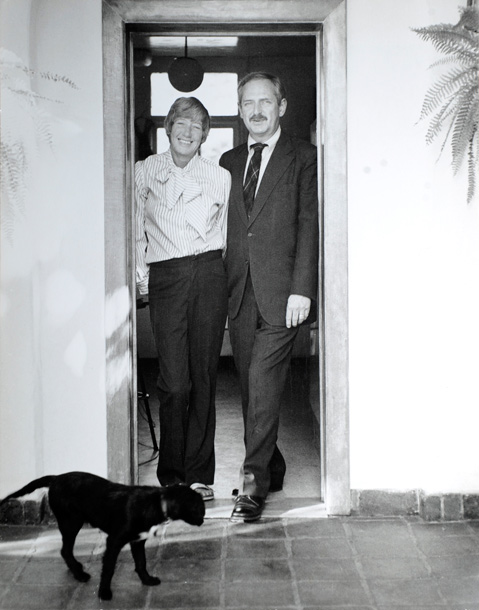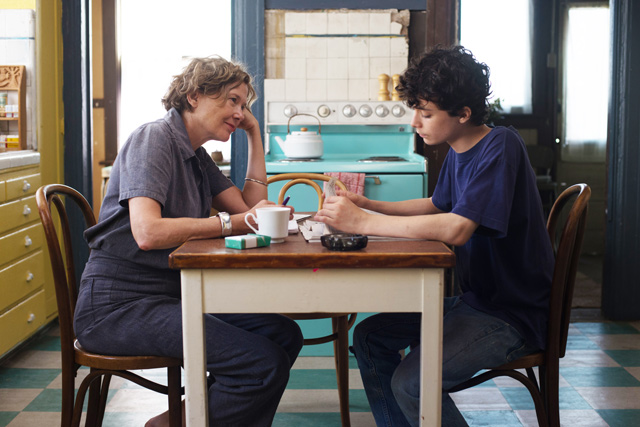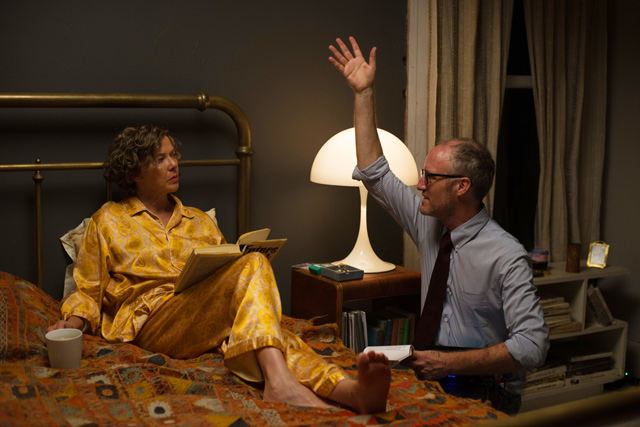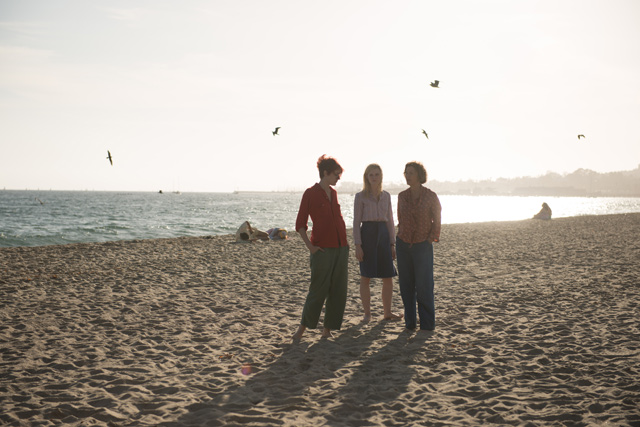Filmmaker Mike Mills Talks ‘20th Century Women’
Family Friend Hilary Dole Klein Reminisces with the Santa Barbara–Raised Writer/Director

Writer/director Mike Mills’s 20th Century Women is his second film to mine the mysteries of his parents. Beginners, released in 2011, was based on the story of Mike’s father, Paul, coming out as a gay man after his wife, Jan, died. It won an Academy Award for star Christopher Plummer. Mills’s newest film, 20th Century Women, is a poignant inquiry into the essence and the enigma of his mother and a testimony to the women he knew growing up in Santa Barbara in the 1970s.
My parents met the Millses soon after Paul became the director of the Santa Barbara Museum of Art, in 1970. At the time, my father, William Dole, was an artist and professor at UCSB, best known for his collages. How perfect, I thought, for my father to be such good friends with the museum director. But when I met the Millses, I saw it was much more than that; the two couples genuinely liked and enjoyed each other, sharing a keen love for art, parties, interesting people, and idealistic causes. I have a note that Jan wrote, describing my mother, Kate, as “one of our dearest friends and one of the most special people in the world.”
The Millses once threw a 6 a.m. birthday party for my mother, in tribute to her love of early rising. My husband and I drove up from Los Angeles for the celebration, which was a vibrant, colorful, happy event. At the time, I was working on a series of honeymoon stories (later excerpted in the News & Review), which included wedding pictures paired with my own portraits. Jan and Paul were one of the couples I interviewed and photographed.

Thus I can claim — and brag about it — that I created art about Mike’s parents years before he dreamed of using them in his movies. Years before he even dreamed of being a film director. As he told me when I visited him recently at his mid-century home in Silver Lake, “First I wanted to be a professional skateboarder. When that didn’t work out, I wanted to be in a band. When that didn’t work out, I went to art school.”
When Mike first told me he was making a film about the various women who “raised” him and later asked me if I knew of a “very big, rundown house,” saying, “I’ve been scouting up [in S.B.], and of course thinking of you and your family,” I thought of the Doles’ big, rundown house and that perhaps my mother was going to be a character in the film — such is my self-centric view. Instead, what I saw in his portrait of his mother, superbly played by Annette Bening, were the things that made Jan and Kate so simpatico. They both wore pants — sometimes jumpsuits — literally and metaphorically. Both of them took care of all the day-to-day operations — the kids, the houses, the finances — leaving the artist and museum director free to concentrate on their muses.
“I always think of your mom and my mom as sort of a team. They’re very different in lots of ways, but they’re very similar in lots of ways,” said Mike. “They were single moms in a sense. My dad was there, and my dad was very sweet, but never very present, emotionally. The raising of me was left to my mom. My sisters were older and had a lot of stuff going on in their lives as good ’70s teenagers — they put on a good show of things that can happen in your life.
“When my mom was sick with a brain tumor,” Mike said, “she couldn’t tell me she had cancer. Your mom came over one day, and, not knowing that I was in the room, Jan said to her, ‘I guess I have that C word.’ There was that tremendous vulnerability. They didn’t have language to deal with their feelings, that generation, and a lot of it came out sideways.”
Mike often gets asked what is true and what is made up about his mother. “It’s based on my mom, but it’s also playing with my mom.” His mother did not recruit girls to help raise him as in the movie, he said. “But she liked to get others to chime in on her raising me. I like to think of it as a kind of socialist mentality. There’s a lot of things she did really say and do that are in the movie and lots of things she didn’t. My rule is if I’m creating a character that my mom would like, then I’m in the safe zone. But it’s a trip even for me to understand how much is or isn’t my mom.” And then Bening’s portrayal adds a new dimension. “My mom inspired my writing. But the performance is Annette’s body and soul and heart and timing,” he said.
Mike and I both often heard, “Oh, your mother is so great,” and we both agree that doesn’t always translate into the most ideal mother. Unlike my mother, Jan was a pragmatic, hardworking businesswoman who knew how to make money, not only with stocks but also with real estate. She always seemed serious, even when she was joking, and she had a sardonic wit. Still, the movie made me see both women better: two strong, smart women, brought up in the 1920s, grappling with marital challenges and unsettling new cultural mores. Mike’s attempt to define his mother allowed me to see my own mother in a clearer, more sympathetic way.
Mike maintains that growing up in matriarchy is what made him women-centric. “To my eyes, power is held by women. You need to please women. And women are the most exciting and the ones who try to help you and don’t beat you up. So I was like ‘women are good,’ and I was trying to figure them out more.” And of course having Greta Gerwig and Elle Fanning play the characters based on his sister and his friends was grandly wish-fulfilling.

I first became aware of Mike when my mother told me the horrendous story of how he fell into an ash pit the day after the Sycamore Canyon Fire in 1977. He suffered second- and third-degree burns on both feet and spent a month in the hospital. My mother would go visit and read to him, and I realized she thought there was something special about him. She was also fascinated by how Jan was raising him.
“My mom let my punk band practice in the house,” Mike remembered. “We would be playing during museum parties. Her friends were like, ‘What?’ And she’d say, ‘He’s doing it, and it’s creative.’ Even though there was nothing musical about it,” he laughed. Jan also took Mike to skate parks and contests all over L.A. “She knew the names of all the tricks. She was a pilot, and she always described skateboarding as like flying.”
When Mike was a junior in high school, she said to him, “So this summer, you have to move out, and you have to pay for it yourself. You’ll have to cook and eat on your own, and you have to get a job.” In January, she told him to start looking for a place. “I ended up living with this 25-year-old guy who was in our band for a minute, and I worked at McDonald’s. It was pretty cool. I did what I wanted, and it was great!”
Jan’s plan was for him to go out and make mistakes and figure things out on his own. “She was desperately afraid of me being spoiled,” he explained. “She used to say, ‘Michael, you’ve got to get out of here as soon as you can. This town is too kinky. There’s too much money, too much leisure.’”
Rather adamantly, Mike corrects people who think 20th Century Women is his own coming-of-age story, fooled possibly because the boy who plays him, Lucas Jade Zumann, is so appealing. “Sorry,” Mike said, “he’s not the protagonist. It’s about what he sees. I’m just there to love the other people.” Were it about him, we would be seeing the portrait of an artist as a young teen. Unlike his character, Mike was always drawing. “And I had to take every single kid art class the museum had anything to do with. I remember that my parents were constantly having parties — like weekly 50-person cocktail and dinner parties, and I’d end up hiding in my room and drawing. I remember Paul Tuttle [an internationally acclaimed designer] would come and hang out because he was sort of shy, and [Kate], too, would come and visit me. I remember them as two people who could talk to you as a kid and not patronize you. I have fond memories of them.
“And I loved your dad’s work — it meant a ton to me. And [Robert] Rauschenberg — I thought I would be an urban Rauschenberg. And that influences this movie. This movie is very much like a collage. It’s all these found objects of memory and cultural artifacts. Just as your dad’s work takes elements with their own specific shapes and torn edges and textures and makes a whole of them, I hunt and gather little found things and find a way to put them together.”

I had the impression when Mike went off to The Cooper Union art school that Jan had bought an apartment for him, and that my mother was very impressed by this. I had it wrong. Mike said that what she did was give him $100,000 and tell him he had to invest it. He could live off the returns, but he had to give the $100,000 back. He bought mutual funds, but it wasn’t enough money to live on, so he lived at the 92nd Street Y and had to get a job. “Which made my mom happy,” said Mike. “‘Oh, you have to work, too? Good!’”
Calling his last two movies “activated portraits,” Mike said that Beginners is more akin to memoir. “All the dad memories are actually much closer to what happened. But if you write it down, it’s one thing, but then to cast it, find a location, light it, and shoot it, it becomes much more fantastical. It’s a magic trick at that point.”
As a writer, I envy how many things Mike can draw from his toolbox to make his writing come alive cinematically and viscerally. Favoring character over plot, he incorporates music, narration, photographs, graphics, color, and the fracturing of time. And yes, it’s a kind of memoir, and yes, it captures the Santa Barbara of 1979, but it builds on this to make a touching, heartfelt, beautiful, funny movie.
Using fiction, memory, and history to examine character, Mike calls his genre memory-based fiction. “Maybe I got this from my mom, but when you refuse to fit into a box, it becomes much more exciting, more alive. You’re a mongrel, though, and it’s harder to raise money and harder to market and harder to award, but it makes me really excited. And it has a kind of feral-ness to it, which is good. It’s not quite playing by any rule.”
I asked him if others besides me have compared him to Woody Allen — albeit a much less neurotic Allen. “They should be,” he agreed. “He’s smarter than me in lots of ways; I’m more schmaltzy; people are nicer to each other in my movies. But in Allen’s best films, his early films, you can just smell that it’s the real thing, that this is a problem he is going through himself. Plus his cinematographer, Gordon Willis, is my favorite. In 20th Century, I’m thinking of Willis and [Federico] Fellini all the time. Fellini’s Amarcord was a big influence. It’s as much about character and place as anything. It’s a little untidy in terms of story, and I like that a lot. And you can tell that these are real memories. Real material.

“I’m so lucky to get to make personal movies. When I’m shooting, I’m keenly aware that this is a once-in-a-lifetime experience. I love the actor’s soul, the actor’s boundary-less emotional soul. We had a lot of fun shooting this. I wear a suit and tie every day — just like my dad — and we have live musicians come and play, and before shooting, we have dance parties.
Mike is not sure what is next for him. He’s been working for a while on a This American Life story to turn it into a film. “I’m doing with the people in the story what I do with myself — getting all their memories from around a specific time. And memories make great film scenes. You know they’re not totally real — real life is impossible to contain. But memories are stopped. And you’ve made a beginning, middle, and end from them.”
Once I saw 20th Century Women, it became one of my own memories, vivid, fleeting, and delicious to ponder. And with this off-beat, articulate, magical film, I got to spend a bit of time with Jan, with all her complications and her challenges, and remember how her heart — like her son’s — was always in the right place.
I left my visit with Mike having had a conversation with a man whose blend of creativity, eloquence, humor, and sensitivity verges on the intoxicating.
My mother was right. Mike Mills is special.



